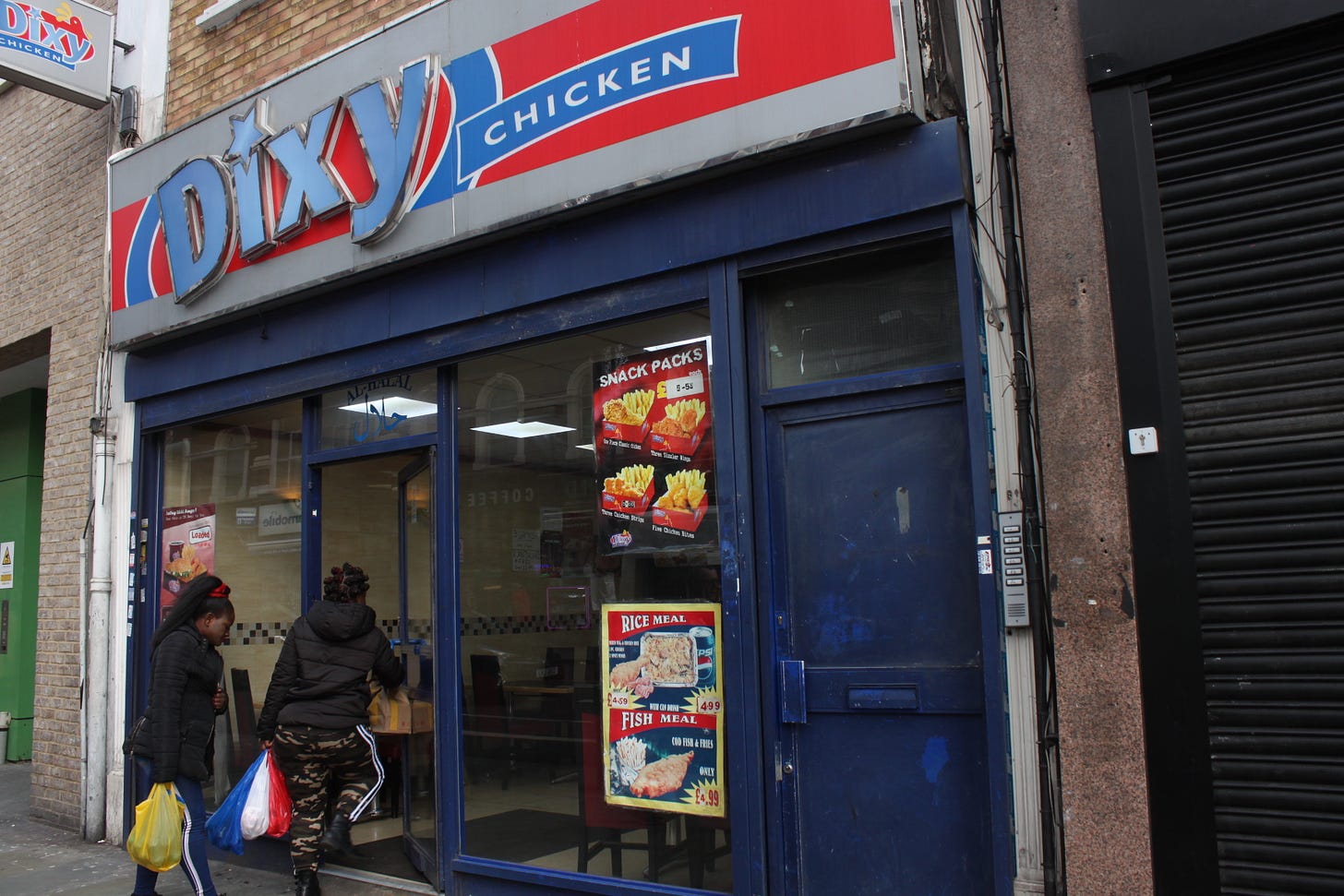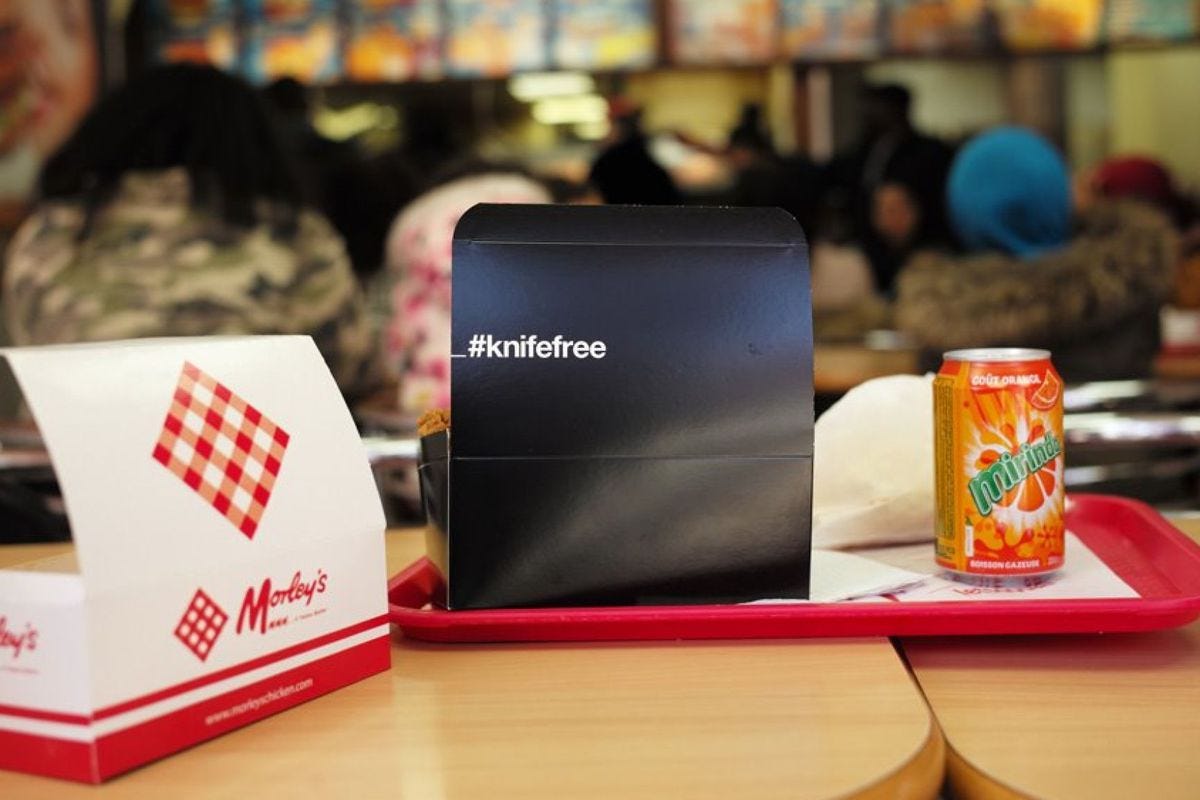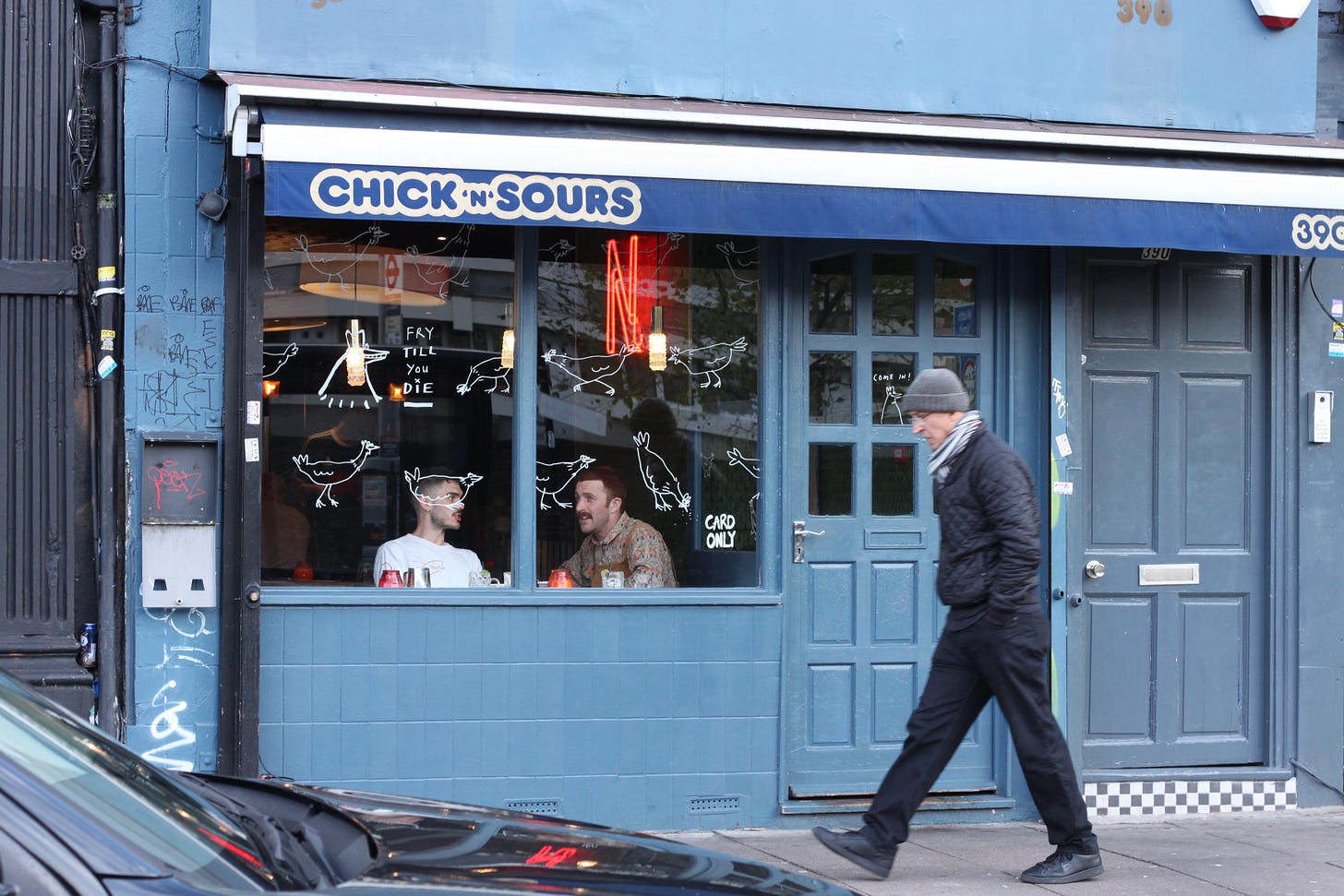The good, the bad and the greasy: the enduring social value of chicken shops
A Dixy Chicken in Dalston resisting change highlights the role of chicken shops as community institutions
*Originally written in 2019 by Fola Olaleye and Xavier Ayub*
Nestled amongst the patchwork streetscape of Dalston’s bustling Kingsland High Street, Dixy is everything you expect from a typical chicken shop: four tables, a three-star hygiene rating, two bossmen and a mountain of fried chicken. The story of its parent franchise is archetypal of any fried chicken chain in London: founded by South Asian immigrants in the 80s and built on the cornerstone of providing cheap, halal alternatives to the products of globalised fast-food corporations.
As we sit inside, a pair of £3.50 meals between us, we hear the successive conversations with Bossman, each varying both in length and levels of playful familiarity. Elderly couples set up camp in the same spot where they’ve come for years, while mums with pushchairs feed their babies tiny chunks of chicken amongst clusters of black and brown school kids.
Traditional chicken shops like Dixy have long been the target of criticism from the government. From child obesity to knife crime, fried chicken regularly finds itself at the centre of controversy surrounding many a social ill. Sadiq Khan has been vocal about tackling the issue of obesity in London, showing particular concern for the health of young Londoners. The Mayor views stemming the greasy tide of chicken shops as a key move in this fight. A ban on new hot food takeaways within 400 metres of London schools is just one of several measures implanted into the London Plan that he hopes will act as barriers to hold back the burgeoning surge of fried poultry.
His rationale holds water. Fundamentally, chicken shops are fast food taken to its logical extreme; the pursuit of speed over healthiness distilled to its purest form. Health agencies point to chicken shops as being responsible for the exceptionally high child obesity rates in London boroughs including Hackney (where child obesity rates lie at over 40%)1. But outside the pages of government documents, the reality is that chicken shops and similar fast food outlets are often the only options some people have. Parents in low-income households and night-workers don’t always have the time and money to buy or cook healthier meals. “You’ve got mums working two jobs, looking after three or four kids with absent fathers,”2 says Stacey-Ann, Dalston resident and one of the older customers in Dixy. “It’s a struggle. Some kids have to fend for themselves.” she laments.
However, this is just one factor fuelling London’s idiosyncratic chicken shop culture. Chicken shops aren’t just a source of cheap food; they also act as social hubs for young people. By 4pm, Dixy is packed with school kids debating philosophical matters such as the difference between melted cheese and cheese sauce. Amongst the after-school rush is a group from a local school. They sit huddled around the table, their uniforms a study in navy and grey. The most vocal of the boys is Isaiah. “The school lunch doesn’t even taste nice. I just save my money so I can go to Dixy with my mates”.3
With the ripples of austerity manifesting in the form of government cuts to youth centres, teenagers like Isaiah have fewer places to spend free time outside the tiled walls of chicken shops. Unfortunately, the cash flow brought by the rapidly materializing luxury towers and trendy coffee shops tends to elude the pockets of deprivation dotted across Dalston. While the government wages a war against chicken shops, it fails to provide alternative spaces for Dalston’s youth to feel safe and fulfilled.
To some, chicken shops are the only things keeping many young people out of the clutches of opportunistic gangs on the hunt for fresh meat. At-risk children escaping unstable, deprived homes often turn to chicken shops as safe havens. However, a government inquiry suggests that in the comfort of chicken shops, lured in with the promise of free chicken, many end up falling into the beckoning hands of those same waiting gangs. This practice of chicken shop grooming, combined with rising knife crime, prompted the government to implement its #knifefree chicken box campaign. In August 2019, boxes printed with anti-knife crime messages were rolled out in chicken shops across the country, including London staples like Morley’s, Chicken Cottage and, of course, Dixy. However, the government’s initiative sparked controversy, swiftly being dubbed as racist.
Clearly, lectures from chicken boxes alone aren’t going to cure London’s crime ailment. The cuts to youth services are just the tip of the iceberg. Other deep-rooted socio-economic issues lie at the heart of the problem. These include the Coalition government’s scrapping of the Education Maintenance Allowance scheme in England, growing exclusion rates in schools, a country-wide housing crisis exacerbated by gentrification, mental health issues among BAME children, and systematic racism4. Stacey-Ann has a simpler explanation: “Those kids, they’ve got the devil in them.”
At the other end of Kingsland Road, sandwiched between corner shops and vast social housing complexes, lies Chick’n’Sours. This establishment prides itself on its use of ethically sourced, free-range, Asian fusion fried chicken. Their chickens come from a small farm in Yorkshire, raised on a diet of over 10 herbs and fresh salad leaves. Evidently, these are very privileged chickens. However, healthy fried chicken is somewhat of an oxymoron, and eating it is an oddly disconcerting experience.
Chick’n’Sours is just one of many similarly trendy enterprises sprouting up in every nook and cranny of Dalston. It is a prime example of food gentrification whereby culturally important and traditionally inexpensive foods become fashionable and unaffordable, spiralling out of the reach of low-income communities. It’s apparent that Chick’n’Sours are trying to cater to a wide customer base with several options on the menu suitable for their ‘vegan and flexitarian friends’. Yet one notable omission is halal chicken: an interesting oversight given Dalston’s sizeable Muslim population. But this isn’t the only form of exclusion occurring at Chick’n’Sours.
If you took a £2 coin to Dixy you’d walk out with a portion of chips and some change. If you walked into Chick’n’Sours with a £2 coin you’d walk back out with the same coin because, firstly, nothing on the menu is that cheap, and secondly, they won’t accept your coin, as they’re a cashless business. This social and financial exclusion undoubtedly contributes to the overwhelmingly homogenous customer base of young white professionals that we find inside. The room is brimming with freelancers snacking on fried chicken with blueberry hoisin sauce; the intellectual discussions of cheese sauce a distant memory. Instead, the air is oozing with talk of architecture drawings and finance.
In this territory, the middle-aged Pakistani bossmen are worryingly absent, replaced with youthful, British chefs and waiters. Cardboard boxes and plastic forks make way for embellished ceramic plates and hefty steel cutlery, and on this end of the road, a meal will set you back around £18. Of course, it comes as no surprise that Chick‘n’Sours has frequently been a contender for the best chicken shop in London in lists curated by the likes of GQ and Timeout, being hailed as “the greatest gift from the god of fried chicken” - a claim we, and no doubt Isaiah, would dispute.
The contrast between Dixy and Chick’n’Sours exposes the social division within Dalston; yet their coexistence reflects how gentrification has also led to local residents and wealthier newcomers going about their daily lives in their respective social bubbles. Dixy challenges the assumed and seemingly ubiquitous trend of newer establishments replacing traditional, local shops. Throughout our time in Dixy, the door barely rested on its hinges, with a steady stream of customers flowing in and out at all hours.
This highlights a key factor that allows Dixy to resist the pressures of gentrification. Dixy plays a twofold social role, first as a source of affordable food and then a safe space for Dalston’s most vulnerable. When combined with the prevalent social housing in the area providing an established customer base for which Chick’n’Sours would not even be an option, it’s clear there will always be a need for Dixy. The chicken shop has been elevated to the level of a community institution. Meanwhile, well-meaning yet naïve outsiders working for not-for-profits are trying to spread the gospel of cheap, healthier food to London’s youth through subsidised food vans. For now though, Bossman has little to worry about, because these poorly-conceived benevolent crusades eventually unravel as many vans overlook the need for halal products.
With chicken shops growing in number across London, while almost every other type of high street shop has been seeing more closures than openings, Dixy is just a microcosm. It may not be unreasonable to speculate that, with its limited social value, lack of a strong foundation in the community, and reliance on potentially short-lived societal trends, Chick’n’Sours may invert expectations of gentrification and disappear before Dixy ever budges.
In Dalston, they’re trying to scrub away the grease, but it just won’t come off.
Dalston Ward Health & Wellbeing Profile 2016.
Stacey-Ann, Dalston resident [interviewed in Dixy on 26 November 2019].
Isaiah, Hackney student. [interviewed in Dixy on 26 November 2019]
Bennett, W. (2018). Knife crime on the rise: what’s behind the violence? Available at: http://socialistreview.org.uk/435/knife-crime-rise-whats-behind-violence





